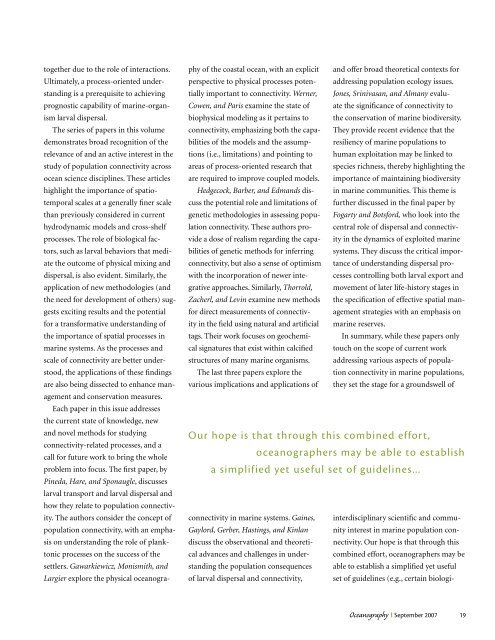Population Connectivity in Marine Systems
Population Connectivity in Marine Systems
Population Connectivity in Marine Systems
Create successful ePaper yourself
Turn your PDF publications into a flip-book with our unique Google optimized e-Paper software.
together due to the role of <strong>in</strong>teractions.<br />
Ultimately, a process-oriented under-<br />
stand<strong>in</strong>g is a prerequisite to achiev<strong>in</strong>g<br />
prognostic capability of mar<strong>in</strong>e-organ-<br />
ism larval dispersal.<br />
The series of papers <strong>in</strong> this volume<br />
demonstrates broad recognition of the<br />
relevance of and an active <strong>in</strong>terest <strong>in</strong> the<br />
study of population connectivity across<br />
ocean science discipl<strong>in</strong>es. These articles<br />
highlight the importance of spatio-<br />
temporal scales at a generally f<strong>in</strong>er scale<br />
than previously considered <strong>in</strong> current<br />
hydrodynamic models and cross-shelf<br />
processes. The role of biological fac-<br />
tors, such as larval behaviors that medi-<br />
ate the outcome of physical mix<strong>in</strong>g and<br />
dispersal, is also evident. Similarly, the<br />
application of new methodologies (and<br />
the need for development of others) sug-<br />
gests excit<strong>in</strong>g results and the potential<br />
for a transformative understand<strong>in</strong>g of<br />
the importance of spatial processes <strong>in</strong><br />
mar<strong>in</strong>e systems. As the processes and<br />
scale of connectivity are better under-<br />
stood, the applications of these f<strong>in</strong>d<strong>in</strong>gs<br />
are also be<strong>in</strong>g dissected to enhance man-<br />
agement and conservation measures.<br />
Each paper <strong>in</strong> this issue addresses<br />
the current state of knowledge, new<br />
and novel methods for study<strong>in</strong>g<br />
connectivity-related processes, and a<br />
call for future work to br<strong>in</strong>g the whole<br />
problem <strong>in</strong>to focus. The first paper, by<br />
P<strong>in</strong>eda, Hare, and Sponaugle, discusses<br />
larval transport and larval dispersal and<br />
how they relate to population connectiv-<br />
ity. The authors consider the concept of<br />
population connectivity, with an empha-<br />
sis on understand<strong>in</strong>g the role of plank-<br />
tonic processes on the success of the<br />
settlers. Gawarkiewicz, Monismith, and<br />
Largier explore the physical oceanogra-<br />
phy of the coastal ocean, with an explicit<br />
perspective to physical processes poten-<br />
tially important to connectivity. Werner,<br />
Cowen, and Paris exam<strong>in</strong>e the state of<br />
biophysical model<strong>in</strong>g as it perta<strong>in</strong>s to<br />
connectivity, emphasiz<strong>in</strong>g both the capa-<br />
bilities of the models and the assump-<br />
tions (i.e., limitations) and po<strong>in</strong>t<strong>in</strong>g to<br />
areas of process-oriented research that<br />
are required to improve coupled models.<br />
Hedgecock, Barber, and Edmands dis-<br />
cuss the potential role and limitations of<br />
genetic methodologies <strong>in</strong> assess<strong>in</strong>g popu-<br />
lation connectivity. These authors pro-<br />
vide a dose of realism regard<strong>in</strong>g the capa-<br />
bilities of genetic methods for <strong>in</strong>ferr<strong>in</strong>g<br />
connectivity, but also a sense of optimism<br />
with the <strong>in</strong>corporation of newer <strong>in</strong>te-<br />
grative approaches. Similarly, Thorrold,<br />
Zacherl, and Lev<strong>in</strong> exam<strong>in</strong>e new methods<br />
for direct measurements of connectiv-<br />
ity <strong>in</strong> the field us<strong>in</strong>g natural and artificial<br />
tags. Their work focuses on geochemi-<br />
cal signatures that exist with<strong>in</strong> calcified<br />
structures of many mar<strong>in</strong>e organisms.<br />
The last three papers explore the<br />
various implications and applications of<br />
connectivity <strong>in</strong> mar<strong>in</strong>e systems. Ga<strong>in</strong>es,<br />
Gaylord, Gerber, Hast<strong>in</strong>gs, and K<strong>in</strong>lan<br />
discuss the observational and theoreti-<br />
cal advances and challenges <strong>in</strong> under-<br />
stand<strong>in</strong>g the population consequences<br />
of larval dispersal and connectivity,<br />
and offer broad theoretical contexts for<br />
address<strong>in</strong>g population ecology issues.<br />
Jones, Sr<strong>in</strong>ivasan, and Almany evalu-<br />
ate the significance of connectivity to<br />
the conservation of mar<strong>in</strong>e biodiversity.<br />
They provide recent evidence that the<br />
resiliency of mar<strong>in</strong>e populations to<br />
human exploitation may be l<strong>in</strong>ked to<br />
species richness, thereby highlight<strong>in</strong>g the<br />
importance of ma<strong>in</strong>ta<strong>in</strong><strong>in</strong>g biodiversity<br />
<strong>in</strong> mar<strong>in</strong>e communities. This theme is<br />
further discussed <strong>in</strong> the f<strong>in</strong>al paper by<br />
Fogarty and Botsford, who look <strong>in</strong>to the<br />
central role of dispersal and connectiv-<br />
ity <strong>in</strong> the dynamics of exploited mar<strong>in</strong>e<br />
systems. They discuss the critical impor-<br />
tance of understand<strong>in</strong>g dispersal pro-<br />
cesses controll<strong>in</strong>g both larval export and<br />
movement of later life-history stages <strong>in</strong><br />
the specification of effective spatial man-<br />
agement strategies with an emphasis on<br />
mar<strong>in</strong>e reserves.<br />
In summary, while these papers only<br />
touch on the scope of current work<br />
address<strong>in</strong>g various aspects of popula-<br />
tion connectivity <strong>in</strong> mar<strong>in</strong>e populations,<br />
they set the stage for a groundswell of<br />
Our hope is that through this comb<strong>in</strong>ed effort,<br />
oceanographers may be able to establish<br />
a simplified yet useful set of guidel<strong>in</strong>es...<br />
<strong>in</strong>terdiscipl<strong>in</strong>ary scientific and commu-<br />
nity <strong>in</strong>terest <strong>in</strong> mar<strong>in</strong>e population con-<br />
nectivity. Our hope is that through this<br />
comb<strong>in</strong>ed effort, oceanographers may be<br />
able to establish a simplified yet useful<br />
set of guidel<strong>in</strong>es (e.g., certa<strong>in</strong> biologi-<br />
Oceanography September 2007 19
















